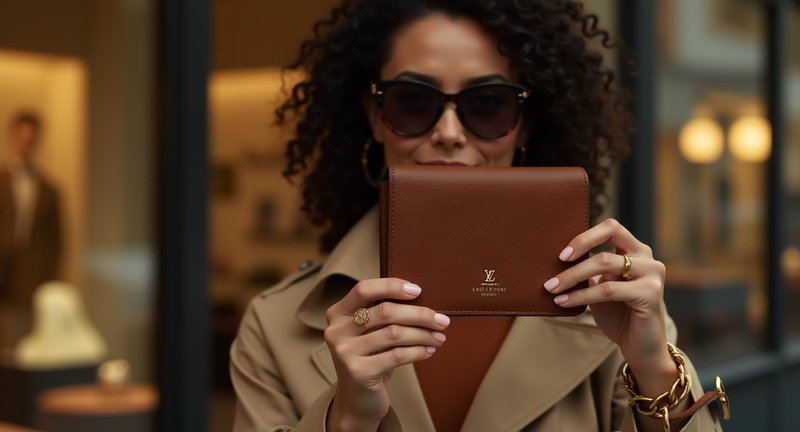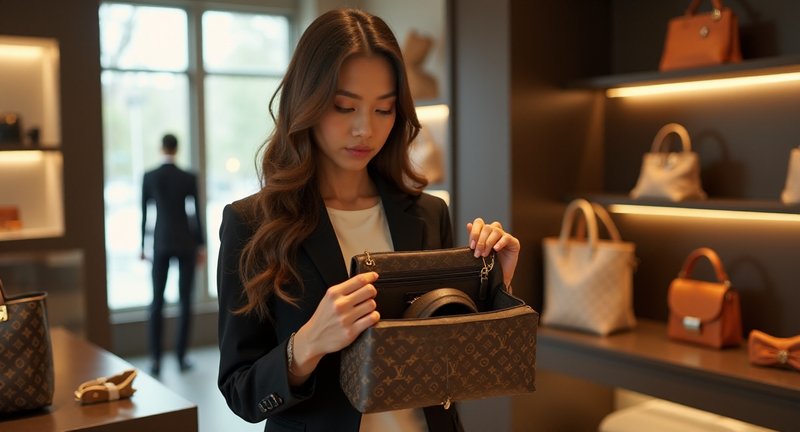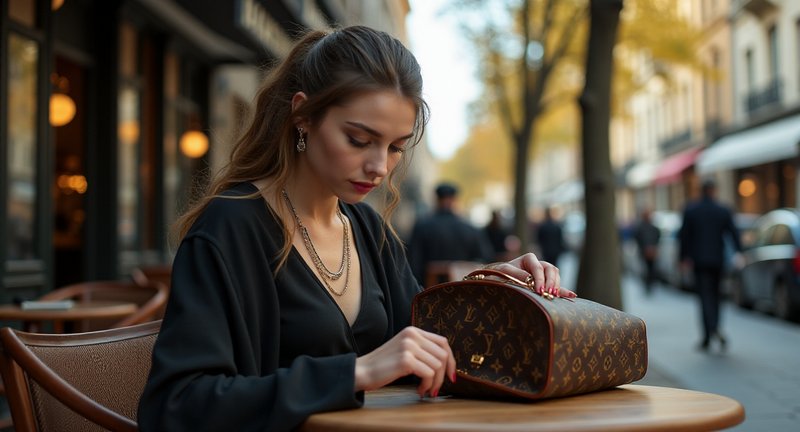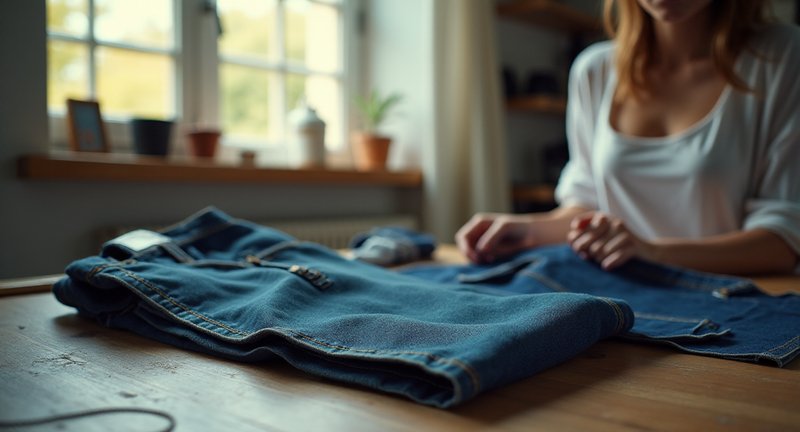Guide to Louis Vuitton Date Code
Navigating the world of luxury fashion can be a labyrinth, especially when it comes to identifying authentic pieces. One intriguing aspect is the Louis Vuitton Date Code, a small yet significant detail embedded in the brand’s craftsmanship.
As a lover of high-end handbags, I remember my excitement upon discovering this secret. The date code serves as a unique identifier, revealing not just the authenticity but also the production date and location of the item.
You might be wondering how to decode this cryptic language. It’s quite simple, actually. Each code consists of a combination of letters and numbers that tell a story about your beloved bag.
For instance, a code like “AR 2174” indicates that it was made in France during the 27th week of 2014. This hidden treasure is more than just a number; it’s a passport for your item, whispering its journey through time and craftsmanship.

In my experience, knowing the Lv production code can elevate your appreciation for the item. It transforms a mere accessory into a piece of art with a rich history.
Always remember, though, that counterfeiters are getting cleverer. So, familiarizing yourself with how to read these codes is crucial in your quest for genuine Louis Vuitton treasures.
Dive deep into the elegance of your handbag and let the Louis vuitton manufacturing date unravel the mysteries of its past. After all, every luxury piece has a story worth telling.
Understanding the Louis Vuitton Date Code
In relation to the allure of luxury handbags, there’s a subtle layer of intrigue hidden beneath the surface an enigmatic system that whispers secrets of authenticity and age. I often find myself captivated by the small details that define high-end fashion pieces, and this particular brand has an exquisite way of marking its creations.
Each bag tells a story through its discreet numerical inscription, almost like a secret handshake among aficionados. It’s not merely a string of digits; it encapsulates the year and location of production, a hidden gem for those who know how to decode its meaning.
On my journey through the world of luxury goods, I’ve learned to appreciate the craftsmanship that goes into every stitch. This small marking, often overlooked, is like a birth certificate for your handbag, lending credibility to its status. It transforms an ordinary accessory into a piece of history, connecting us to the artistry behind it.

The thrill of discovering this detail brings a sense of satisfaction akin to finding a rare coin in your pocket. It’s a reminder that every item has its roots, its beginnings, and an unmistakable charm that defines its journey through time.
When you clutch a designer piece, remember that this subtle inscription is more than just a number; it’s a glimpse into the world where fashion meets artistry. The next time you admire a luxury handbag, take a moment to explore its hidden markers and revel in the tales they tell.
Introduction to Authenticity in Luxury Fashion
In the point of luxury fashion, authenticity is not just a badge of honor; it’s the very essence that breathes life into every meticulously crafted piece. From my own experiences wandering through boutiques and engaging with passionate sellers, I’ve come to appreciate the nuances that define authenticity in this captivating world.
When you invest in luxury fashion, you’re not merely purchasing an item; you’re acquiring a slice of art, history, and craftsmanship. Here are a few key elements to keep in mind when navigating this intricate landscape:
-
Craftsmanship: Luxury brands pride themselves on impeccable craftsmanship. Inspect the stitching, materials, and overall construction. A genuine item will exhibit meticulous attention to detail that a counterfeit simply cannot replicate.
-
Brand Heritage: Understanding the brand’s history can enhance your appreciation for their pieces. Each label carries its unique story, shaped by artisans and designers over generations.
-
Serial Markings: Familiarize yourself with specific identifiers that verify a piece’s authenticity. While some brands use numerical codes or inscriptions, the nuances can vary. It’s vital to do your research.
-
Packaging: The unboxing experience of a luxury item is often as enchanting as the product itself. High-quality packaging, complete with authenticity cards and dust bags, adds to the allure and authenticity.
-
Community Insight: Engaging with communities both online and offline can offer invaluable insights. Collectors and enthusiasts often share tips and tricks that can enhance your understanding of authenticity.
In this vibrant world, being knowledgeable is your best ally. So, the next time you gaze upon a stunning handbag or a pair of exquisite shoes, remember: authenticity isn’t just about what you see; it’s about what you feel and understand. Dive deep into the story behind each piece and relish the journey of discovery.
The Importance of Date Codes in Luxury Items
With a focus on luxury fashion, understanding the significance of date codes can feel like unearthing a hidden treasure. These seemingly innocuous sequences often carry a wealth of information, revealing the authenticity and origin of coveted pieces.
In my own journey through the world of high-end items, I’ve discovered that these codes serve as a passport to the past. They whisper stories about where, when, and how a piece was made, transforming an ordinary accessory into a narrative of craftsmanship.
Imagine holding a bag that not only dazzles with its beauty but also possesses a unique history. Each time I check the code, I feel a connection to the artisans who poured their skill into every stitch. It’s a reminder that luxury is not just about opulence; it’s about the artistry behind it.
Moreover, being able to decipher these codes empowers us as consumers. It’s like having a secret decoder ring that grants us access to the truth. Knowing how to spot the genuine article from the counterfeit helps safeguard our investments in style.
I’ve seen countless enthusiasts become captivated by this aspect of luxury goods. It’s an adventure of sorts, one that deepens our appreciation for what we choose to adorn ourselves with. By understanding these cryptic numbers and letters, we can celebrate authenticity over mere brand prestige.
So, the next time you find yourself drawn to a luxury item, take a moment to explore its date code. Who knows? You might just uncover a fascinating story that makes your purchase even more special.
What Are Date Codes?
When diving into the world of luxury fashion, one can’t help but notice the allure of those tiny, cryptic identifiers often tucked away in the seams of a bag. These little gems, often overlooked, are what we call date codes. From my experience, they’re like a secret language, whispering the history of a piece to those who know how to listen.
Imagine owning a piece that’s more than just a beautiful accessory; it’s a slice of time and craftsmanship. Each code is a timestamp, telling us when and where the item was born, much like a birth certificate for your favorite handbag. Isn’t it fascinating to think about the hands that stitched it, the materials chosen, and the time in which it was created?
The codes can be found in different locations depending on the piece, sometimes cleverly hidden in a pocket or lining. It’s like a scavenger hunt, and finding it adds a layer of intimacy with the item. When I finally located the code in my own bag, it felt like uncovering a hidden treasure.
Understanding these identifiers not only enhances our appreciation for luxury items but also helps in discerning the genuine from the counterfeit. In a world brimming with replicas, knowing how to decode these little symbols can save you from heartbreak and financial loss.
So, the next time you’re admiring a luxury piece, take a moment to seek out its date code. You might just discover a story waiting to be told, a connection to the past, and a deeper appreciation for the craftsmanship that defines high fashion.
The History of Louis Vuitton’s Authenticity Measures
When I think about the fascinating history of Louis Vuitton’s dedication to ensuring authenticity, I can’t help but admire their commitment to craftsmanship. They’ve never settled for the easy route, and that’s what makes their approach to verification so iconic.
From the very beginning, Louis Vuitton understood the value of trust. But let me tell you, they didn’t just sit back and hope their customers would believe in them. They were ahead of the game, implementing measures that would make their products unmistakably theirs.
One thing that always stands out is how they’ve evolved. Over the decades, Louis Vuitton has woven tiny, almost invisible threads of authenticity into every piece they create. It’s like they’re playing a quiet but powerful game of chess, staying one step ahead of counterfeiters.
What’s really impressive is that these measures are not only about protecting the brand, but also about giving their customers a sense of exclusivity. Every Louis Vuitton item feels personal, like it’s telling you a secret that only true fans would know how to uncover.
Of course, these days, technology has taken authenticity to a new level. But even as Louis Vuitton incorporates digital methods, they haven’t lost the touch of traditional artistry that makes their pieces so unique. There’s an elegance to how they balance the old with the new, ensuring that while styles may change, the promise of genuine luxury remains timeless.
How to Locate the Date Code on Louis Vuitton Products
Finding that tiny code hidden in your Louis Vuitton piece can feel like a mini treasure hunt, but it’s totally worth it. The tricky part is knowing where to start. I’ve seen my fair share of these codes tucked away in all sorts of places, and while it might seem overwhelming, it’s actually quite fun once you know what to look for.
Here’s a general rule of thumb: the code is often discreet, sometimes almost camouflaged into the fabric or leather. For example, in handbags and wallets, it can be found stamped directly onto the inner lining or on a small leather tab, usually located inside a pocket. Some bags make you really work for it, with the code hidden at the very bottom of the interior or in a pocket so tight you’ll feel like you’re cracking a secret safe.
To make things easier, here’s a quick breakdown of typical spots for different items:
- Handbags: Inside pockets, either stamped on the lining or a small leather tab.
- Wallets & Small Leather Goods: Often tucked into a fold or hidden in a pocket corner.
- Luggage & Larger Bags: Check under flaps, inside zipper pockets, or along seams.
One thing I’ve learned is that patience is key. Some older pieces may have worn-out codes, and the newer ones may have them embedded in spots that require a bit more effort to find. But trust me, the satisfaction of spotting that tiny imprint is worth every second.
So, next time you’re digging around inside your bag, take a moment to see if you can uncover that elusive little stamp. It’s a fun way to connect with the craftsmanship behind your piece!
Decoding the Numbers: What They Mean
As it relates to deciphering those seemingly cryptic digits on luxury bags, it’s like learning a new language a secret one that’s written in numbers and letters. So, let’s break it down, step by step.
First off, these codes are not just random sequences but actually a blend of letters and numbers that reveal quite a bit about the item’s origins. You can think of it as the luxury world’s version of a fingerprint.
- The letters usually represent the location where the bag was made. It’s a fun detail, as each country or specific workshop often has its own unique code.
- The numbers are tied to the manufacturing date, and they’re not as straightforward as they seem. Don’t expect to see a simple month and year format. Instead, you’ll find something that reads more like a puzzle, sometimes using two digits for the week and two for the year, depending on the decade the bag was produced.
There’s also a twist: the format has evolved over time. That means an older bag may have a different coding style compared to a more recent model. Understanding these variations is key if you’re trying to get to the bottom of when and where your piece was made.
Here’s a quick example to bring it to life. Imagine you’ve got a bag with the code ‘FL0021.’ Those first two letters (FL) would indicate the country of manufacture. The last four digits here’s where it gets tricky could mean that the bag was crafted in the 2nd week of 2021. Cool, right?
Learning to read these codes takes a bit of practice, but once you know the pattern, you can spot the origin and date of a piece in seconds, adding a little more luxury knowledge to your shopping game.
Common Misconceptions About Date Codes
When dealing with designer handbags, there’s a lot of buzz surrounding the ‘Louis Vuitton Date Code.’ But let me clear the air: many people, even seasoned collectors, hold onto a few common misconceptions about it.
First off, let’s get one thing straight: a date code is not a serial number. That’s right unlike what you might expect from other luxury brands, Louis Vuitton uses date codes solely for manufacturing purposes, not as an authenticity marker. If you’ve been using the date code as your litmus test for verifying a bag’s authenticity, it’s time to rethink that strategy.
Here are some of the most common misconceptions:
-
Misconception #1: The date code proves authenticity.
Truth is, counterfeiters have gotten really good at replicating these codes, so relying on them alone won’t cut it. -
Misconception #2: The date code tells you where your bag was made.
Not entirely true. While the code provides a region, it doesn’t give specific factory information. A bag with a French date code could still have been assembled elsewhere. -
Misconception #3: Every Louis Vuitton bag has a date code.
Believe it or not, some older models and smaller accessories don’t have one at all. So, if you can’t find it, don’t panic just yet!
Instead of focusing purely on the date code, you should also look at other tell-tale signs of authenticity, like craftsmanship, materials, and stitching. Date codes are just one piece of the puzzle, and not the whole story.
Next time someone brings up the ‘Louis vuitton manufacturing code’ in a conversation, you’ll know exactly how to steer them in the right direction. Armed with this knowledge, you’ll avoid falling into the trap of common misconceptions.
Differences Between Date Codes and Serial Numbers
In relation to designer goods, two terms often float around date codes and serial numbers. It’s easy to mix them up, but trust me, they’re quite different. The confusion, though, is understandable since they both serve as markers of authenticity.
A date code typically gives you a glimpse into when and where an item was produced. Think of it as a shorthand for the item’s origins. It’s not something that screams out at you, but once you know where to look, it offers some fascinating insights.
Serial numbers, on the other hand, are like the fingerprint of the item. Unique and unrepeatable. Each piece gets its very own number, making it easier to track. If you ask me, it’s this number that provides a much deeper sense of individuality.
While both serve to authenticate, date codes help with time, while serial numbers confirm identity. If you’ve ever held a piece in your hands and wondered about its journey, these codes are the breadcrumbs.
Now, a word of advice understanding these little details can help you dodge counterfeit items. It’s like a secret language that opens the door to an entire world of knowledge. Trust me, once you learn it, you won’t look at a bag or a wallet the same way again.
How to Verify a Louis Vuitton Date Code
As it relates to unraveling the mystery of those little numbers and letters stamped inside your favorite luxury bag, it’s a bit like decoding a secret message. From my experience, this tiny code holds a treasure trove of information. It tells you the bag’s origin, age, and sometimes even a hint of the craftsmanship behind it.
First things first, check where the code is located. In my encounters, it’s usually tucked away in one of two spots: near a seam on the inside or discreetly pressed onto a leather tab. If you’re not spotting it at first glance, don’t worry it’s subtle.

Here’s the fun part: once you’ve found the stamp, it’s time to play detective. The letters typically represent the country where the bag was made. You’ll often find combinations like ‘FR’ for France or ‘SP’ for Spain. The numbers, however, are your true time machine. Depending on the bag’s era, these digits may represent the week and year of manufacture or other slightly more cryptic data.
A few tips for making sure you’ve got a genuine bag:
- Inspect the font: The stamp should be crisp, consistent, and free of smudges. If the letters look too bold or misaligned, that’s a red flag.
- Feel the leather: If the code is heat-stamped into leather, it should blend seamlessly with the texture no peeling or fading.
- Cross-check: Once you’ve decoded the letters and numbers, cross-reference the info with the brand’s production patterns. It’s always rewarding when it all clicks into place!
And don’t forget, this process should be fun, like piecing together a stylish puzzle!
Visual Indicators of Authentic Louis Vuitton Items
One thing that always catches my eye is the impeccable craftsmanship. Every stitch is perfectly aligned, almost like it’s daring you to find a flaw. A real Louis Vuitton piece has stitching that’s both neat and consistent, as if the artisans poured over every inch with care.
Another sign is the pattern. Trust me, I’ve seen enough to know how crucial this is. The iconic LV monogram doesn’t just slap itself onto a canvas haphazardly. It’s symmetrical, perfectly balanced, and always strategically placed, even around the seams.
When you hold a genuine piece, you can practically feel the history. The weight is a subtle, but telling factor. The leather, oh the leather, it feels firm yet buttery, softening over time but never losing its luxurious character.
Of course, the hardware. I can’t count how many times I’ve examined zippers and clasps. On an authentic Louis Vuitton, the hardware feels solid, with a soft sheen that doesn’t scream but subtly gleams. It’s those little things like the flawless engraving on the metal that stand out.
The inside is where some of the magic hides. That rich, velvet-like interior in certain bags, or the pristine canvas linings, never feel cheap or flimsy. When you run your fingers over it, it’s like touching luxury itself.
And lastly, there’s something about the smell. It’s not overwhelming, but that distinct, leathery scent lingers, adding an extra layer of authenticity. You might think I’m exaggerating, but trust me, once you’ve smelled the real deal, it’s hard to forget.
The Role of the Date Code in Product Value
In the world of luxury fashion, small details can wield a surprising amount of power. One such detail, often overlooked by casual shoppers but cherished by collectors, is the date code. It’s more than just numbers and letters it’s like a secret handshake between the brand and its most dedicated fans. From my experience, this seemingly hidden feature can play a significant role in determining the value of a high-end item.
Let’s break it down. Why is this code so crucial?
- Proof of Authenticity: The presence of a date code confirms that the item was crafted by the brand, adding an extra layer of confidence for those in the market for pre-owned goods.
- Age Verification: Date codes help track the item’s age, which can impact its market value. A vintage piece in excellent condition may become more desirable with time.
- Rarity Factor: Certain codes indicate that a product was made during limited production runs. If you’re a collector, you know that this scarcity can make an item far more valuable.
- Condition Expectations: The date code also sets expectations. A well-preserved item from the early 2000s with a matching code? That’s a winner in the second-hand market. On the flip side, an item with visible wear that doesn’t align with its age might raise questions.
Whether you’re buying or selling, understanding the importance of date codes allows you to navigate the luxury market with a sharper eye. It’s like having the inside scoop on a brand’s timeline, and trust me, that knowledge can translate into real dollars. So, next time you’re examining a designer piece, don’t forget to peek at this little secret your wallet might thank you later.
Other Authentication Methods for Luxury Bags
There are more ways to authenticate luxury bags than simply relying on serial numbers or codes. From my personal experience, the devil is often in the details, and these finer points can speak volumes.
One method I’ve come to appreciate is the stitching technique. Genuine craftsmanship is reflected in perfectly uniform stitches each one like a mini-masterpiece. Counterfeit bags often miss this mark, with uneven or loose threads revealing their secrets.
Then there’s the material itself. Leather has a story to tell. High-end bags use the finest materials, so if it doesn’t smell or feel luxurious, it’s a red flag. The texture, weight, and even how the material ages give away the authenticity.
Another subtle indicator is the hardware. Authentic luxury bags often use custom, solid metal pieces, with logos or branding engraved meticulously. Fake bags, on the other hand, use cheap, lightweight hardware that might tarnish or peel over time.
Also, pay attention to packaging. From dust bags to certificates of authenticity, everything should feel as luxurious as the bag itself. Authentic brands take care in every detail, even those that may seem insignificant.
When you’re inspecting a bag, remember luxury is about the experience. Every inch should whisper elegance and quality, never shout mediocrity.
Tips for Spotting Fake Louis Vuitton Products
With respect to spotting a fake Louis Vuitton, trust me, the devil is in the details. One of the first things that should grab your attention is the stitching. Real Louis Vuitton pieces boast perfectly even, consistent stitching no missed stitches, no frayed edges. If the seams look sloppy, you’re likely staring at an imposter.
Next, focus on the hardware. Genuine LV products use top-quality brass or gold-toned metal, which feels heavy in hand. A fake often skips on this detail, opting for cheap, lightweight materials that just don’t have the same shine or heft. If it feels flimsy, you’re probably holding a knockoff.
Another telltale sign is the logo itself. On authentic items, the monogram is meticulously placed, never cut off or oddly aligned. Look for symmetry in the logo pattern, especially where it meets the seams. A sloppy logo screams counterfeit faster than anything else.
Then there’s the leather. Louis Vuitton uses natural cowhide leather, which gradually develops a honey-colored patina over time. If the leather stays light and doesn’t age, it’s not the real deal. Trust me, there’s nothing quite like the smell and feel of the genuine leather used by LV.
As a matter of fact, pay attention to the packaging. Authentic Louis Vuitton products come with high-quality packaging that feels luxurious. If you receive a flimsy box or poorly printed dust bag, you can be sure something’s off. It’s these little things that make all the difference.
Clear Explanations
How do I verify a Louis Vuitton manufacturing code?
To verify a Louis Vuitton date stamp, you should first check the format, which typically consists of two letters followed by four numbers. The letters represent the factory location, while the numbers indicate the week and year of production. For example, ‘FL0091’ would mean the bag was made in France in the 9th week of 2001. Be aware that Louis Vuitton switched to microchips in 2021, so newer items might not have traditional date codes.
How do I check my LV authentication?
To authenticate your Louis Vuitton item, you should inspect several factors, including the quality of materials, craftsmanship, and stitching. Check the date code to ensure it matches the supposed country of origin and production time. Compare the item’s logo placement, hardware, and canvas patterns with authentic Louis Vuitton pieces. For further certainty, consider using third-party authentication services or Louis Vuitton’s official store to verify the product’s authenticity.
What are the country codes for Louis Vuitton?
Louis Vuitton uses specific letters as country codes within the date code to indicate the manufacturing location. Some common ones include ‘FR’ for France, ‘SP’ for Spain, ‘CA’ for Canada, ‘TH’ for the United States, and ‘MI’ for Italy. Recognizing these codes can help confirm the item’s authenticity, as they must match the country where the Louis Vuitton factory is located.
Why is there no date code on my Louis Vuitton wallet?
If your Louis Vuitton wallet doesn’t have a date code, it may have been produced after 2021, when Louis Vuitton began transitioning to microchips for authenticity tracking. Older wallets could also have a worn-off or misplaced date code due to regular use. Check hidden areas like the interior pockets or card slots, but if you’re still unable to find it, you may want to verify the wallet’s authenticity through a professional service.
What is the DK code for Louis Vuitton?
The ‘DK’ code refers to items produced in France. Each Louis Vuitton product has a unique date code that typically consists of letters and numbers. The letters represent the factory where the product was made, and ‘DK’ signifies the French origin. However, it’s important to cross-check this information with other details like craftsmanship and overall product quality when verifying authenticity.
How to check LV wallet authenticity?
To check the authenticity of a Louis Vuitton wallet, examine the stitching, which should be uniform and precise. The materials, such as leather and canvas, should feel durable and high-quality. Check for the presence of a date code or microchip, depending on the wallet’s production year. Also, the monogram should be perfectly symmetrical, and the logo embossing should be crisp. For certainty, professional authentication services are highly recommended.
How to tell if a bag is authentic?
To determine if a Louis Vuitton bag is authentic, look for several key indicators. The quality of the materials should be top-notch, with flawless stitching and craftsmanship. Inspect the logo placement, hardware engravings, and check the date code, which should align with the production location and time. You can also verify the bag through professional authentication services or by visiting a Louis Vuitton store, where experts can help confirm its authenticity.
How to scan a Louis Vuitton microchip?
As of 2021, Louis Vuitton has incorporated microchips into its products for authenticity verification. These microchips can be scanned by authorized Louis Vuitton personnel using special scanning devices. Unfortunately, the microchips are not designed for public scanning through smartphones or other personal devices, so you’ll need to visit a Louis Vuitton store to have the microchip scanned and the item’s authenticity confirmed.
How to tell if a Louis Vuitton bracelet is real?
To determine if a Louis Vuitton bracelet is real, start by inspecting the quality of the materials, such as leather or metal. Authentic bracelets will have precise engravings, clean finishes, and no imperfections. Check for the Louis Vuitton logo, which should be clearly and accurately engraved. Look for a date code or serial number depending on the production year. If in doubt, consider professional authentication services for a reliable assessment.
How do I know if my LV is original?
To know if your Louis Vuitton item is original, you should check its overall quality, including the stitching, materials, and craftsmanship. The logos should be symmetrical and precise, while the hardware should have clear engravings and feel substantial. If the item has a date code, ensure it matches the country of production. Consider using third-party authentication services if you’re unsure, or take it to a Louis Vuitton store for expert verification.
Do all Louis Vuitton items have a date stamp?
Not all Louis Vuitton items have date stamps anymore. Historically, Louis Vuitton used date codes to indicate the manufacturing date and location. However, starting in 2021, Louis Vuitton transitioned to using microchips in their items for authentication, eliminating the need for visible date codes. If your item is newer, it likely contains a microchip instead of a date stamp. For older items, the date code is typically found in hidden areas of the product.
Do real Louis Vuitton have barcodes?
Authentic Louis Vuitton items do not have barcodes directly on the product itself. Instead, barcodes may appear on the packaging or sales tags associated with the item. If you see a barcode on the actual Louis Vuitton product, this could be a red flag indicating a counterfeit. To ensure authenticity, focus on other factors such as the date code, craftsmanship, and material quality, or have the item professionally authenticated.











This is such an important clarification! I used to think the date code was the ultimate proof of authenticity, but now I see it’s not that simple. It’s crazy how well counterfeiters can replicate those codes these days. Definitely a reminder to pay more attention to other details like stitching and materials. Thanks for the insight!
Wow, I never knew how much those seemingly random letters and numbers actually tell you about a bag’s history! I love the idea of it being a kind of secret language that you can decode to uncover when and where a piece was made. It really adds a whole new layer of appreciation when shopping for luxury items. That example you gave with ‘FL0021’ totally helped me understand how the date codes work – I can imagine myself showing off this newfound knowledge next time I’m looking at vintage pieces with friends! Definitely gives you a bit of an edge when you can crack these codes.
Oh wow, this actually brings back memories of when I first discovered the date code on one of my old Louis Vuitton pieces! It really does feel like a mini treasure hunt, and once you find that little code, it’s like you’ve unlocked a hidden part of the bag’s story. I totally agree with the patience part – sometimes it’s a bit of a challenge, especially when you’re rummaging through pockets and folds trying to spot it. I remember having a moment of “is this even real?” because I couldn’t find the code in one of my older pieces. It took forever to spot it, but I felt like a detective once I did. It’s true that it gives you a whole new appreciation for the craftsmanship when you realize how cleverly it’s hidden. These tips you’ve shared are super helpful, especially for anyone who’s starting out and doesn’t quite know where to look. It turns the whole experience into something so much more personal!
I love how you highlighted Louis Vuitton’s long-standing dedication to authenticity it’s truly something that sets them apart. The way they’ve integrated those almost invisible markers of authenticity over the years is nothing short of genius. It really does feel like they’re playing a game of chess with counterfeiters, always staying one step ahead while maintaining the elegance and craftsmanship they’re known for. I’ve noticed that in recent years, especially with vintage pieces, these subtle details make such a big difference. It’s like owning a little piece of fashion history, and it’s so cool how they’ve balanced the timelessness of their craft with new-age tech for verification. I also appreciate how, even as they embrace modern methods, they’ve kept that signature feel of exclusivity alive. When I carry my LV bag, I don’t just feel like I’m making a fashion statement I feel like I’m carrying a piece of the brand’s legacy. It’s this blend of tradition and inno
Totally agree finding those date codes really is like a scavenger hunt! I recently got into luxury bags, and locating the code for the first time was a fun and satisfying moment. It’s amazing how something so small can hold so much information about when and where the item was made. Makes the bag feel more personal, like it has its own story to tell. I’ll definitely keep an eye out for these little gems in the future!
I couldn’t agree more with your take on date codes being like little treasure maps! When I first started getting into luxury fashion, I had no idea how much these tiny details could reveal. It’s like each bag or accessory has its own secret history, and being able to tap into that is incredibly satisfying. I had a similar experience with a vintage handbag I bought. When I checked the date code and realized it was from the early ’90s, I immediately felt connected to that era. The idea that these codes can transport us back in time and show us the craftsmanship behind each piece really adds a whole new layer of appreciation. I totally get what you mean about feeling empowered too. It’s such a relief knowing I can confidently tell a real piece from a fake, especially in a world where counterfeits are everywhere. The whole process of decoding feels like being part of an exclusive club, right? And honestly, the next time I’m out shopping for something luxurious, I’ll defini
I couldn’t agree more with the idea that luxury fashion is so much more than just an accessory it’s a piece of history, art, and craftsmanship all rolled into one. The way you describe authenticity as the “essence” of luxury really resonates with me. I’ve had the pleasure of learning about these things through conversations with collectors, and it’s amazing how much detail goes into ensuring each piece stands the test of time. From the meticulous stitching to the brand heritage, it’s fascinating to see how each element plays a part in creating something truly special. The unboxing experience you mentioned is so true as well there’s something magical about opening a beautifully packaged item that you know has been carefully crafted. The added touch of serial markings and authenticity cards only enhances that feeling. And I totally agree that engaging with fellow enthusiasts is a great way to stay informed and avoid getting tricked by counterfeits. Thanks for this
I totally agree with you! Those small, hidden codes add such an interesting element to a luxury handbag. It’s like finding a hidden treasure that tells you where and when it was born! Such a cool way to connect with your piece.
I never realized how much history could be packed into such a small detail! The Louis Vuitton date code definitely adds another level of intrigue to owning a luxury item. It’s like the bag has its own little biography where it was made and when it was crafted. As someone who appreciates both the artistry and functionality of high-end handbags, this extra layer of knowledge really elevates the experience for me. Knowing how to decode it feels like a secret handshake between those who truly appreciate craftsmanship. And you’re right counterfeiters are getting better all the time, so familiarizing ourselves with these details can make all the difference when investing in something like this. I love the idea of my handbag having a hidden passport that tracks its journey through time! Thanks for the insight now I’ll be checking the date codes on every Louis I come across.